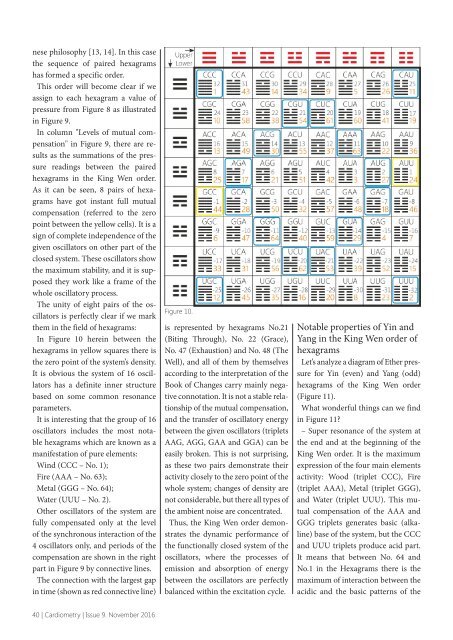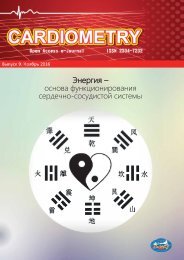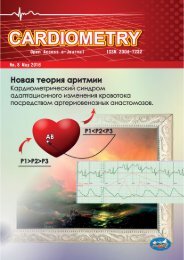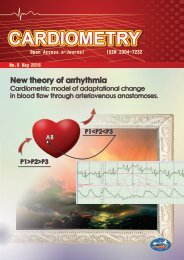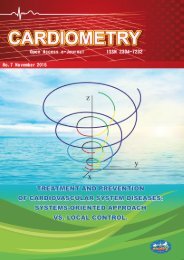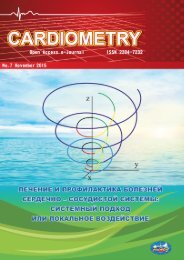Open access e-journal Cardiometry - No.9 November 2016
As might be seen, our Journal is a theme-oriented publication so that each issue offers concentrated materials targeting a certain topic. The present publication is treating the very topical problem: it is energy of the heart.
As might be seen, our Journal is a theme-oriented publication so that each issue offers concentrated materials targeting a certain topic. The present publication is treating the very topical problem: it is energy of the heart.
Create successful ePaper yourself
Turn your PDF publications into a flip-book with our unique Google optimized e-Paper software.
nese philosophy [13, 14]. In this case<br />
the sequence of paired hexagrams<br />
has formed a specific order.<br />
This order will become clear if we<br />
assign to each hexagram a value of<br />
pressure from Figure 8 as illustrated<br />
in Figure 9.<br />
In column "Levels of mutual compensation"<br />
in Figure 9, there are results<br />
as the summations of the pressure<br />
readings between the paired<br />
hexagrams in the King Wen order.<br />
As it can be seen, 8 pairs of hexagrams<br />
have got instant full mutual<br />
compensation (referred to the zero<br />
point between the yellow cells). It is a<br />
sign of complete independence of the<br />
given oscillators on other part of the<br />
closed system. These oscillators show<br />
the maximum stability, and it is supposed<br />
they work like a frame of the<br />
whole oscillatory process.<br />
The unity of eight pairs of the oscillators<br />
is perfectly clear if we mark<br />
them in the field of hexagrams:<br />
In Figure 10 herein between the<br />
hexagrams in yellow squares there is<br />
the zero point of the system’s density.<br />
It is obvious the system of 16 oscillators<br />
has a definite inner structure<br />
based on some common resonance<br />
parameters.<br />
It is interesting that the group of 16<br />
oscillators includes the most notable<br />
hexagrams which are known as a<br />
manifestation of pure elements:<br />
Wind (CCC – No. 1);<br />
Fire (AAA – No. 63);<br />
Metal (GGG – No. 64);<br />
Water (UUU – No. 2).<br />
Other oscillators of the system are<br />
fully compensated only at the level<br />
of the synchronous interaction of the<br />
4 oscillators only, and periods of the<br />
compensation are shown in the right<br />
part in Figure 9 by connective lines.<br />
The connection with the largest gap<br />
in time (shown as red connective line)<br />
Figure 10.<br />
is represented by hexagrams No.21<br />
(Biting Through), No. 22 (Grace),<br />
No. 47 (Exhaustion) and No. 48 (The<br />
Well), and all of them by themselves<br />
according to the interpretation of the<br />
Book of Changes carry mainly negative<br />
connotation. It is not a stable relationship<br />
of the mutual compensation,<br />
and the transfer of oscillatory energy<br />
between the given oscillators (triplets<br />
AAG, AGG, GAA and GGA) can be<br />
easily broken. This is not surprising,<br />
as these two pairs demonstrate their<br />
activity closely to the zero point of the<br />
whole system; changes of density are<br />
not considerable, but there all types of<br />
the ambient noise are concentrated.<br />
Thus, the King Wen order demonstrates<br />
the dynamic performance of<br />
the functionally closed system of the<br />
oscillators, where the processes of<br />
emission and absorption of energy<br />
between the oscillators are perfectly<br />
balanced within the excitation cycle.<br />
Notable properties of Yin and<br />
Yang in the King Wen order of<br />
hexagrams<br />
Let’s analyze a diagram of Ether pressure<br />
for Yin (even) and Yang (odd)<br />
hexagrams of the King Wen order<br />
(Figure 11).<br />
What wonderful things can we find<br />
in Figure 11?<br />
– Super resonance of the system at<br />
the end and at the beginning of the<br />
King Wen order. It is the maximum<br />
expression of the four main elements<br />
activity: Wood (triplet CCC), Fire<br />
(triplet AAA), Metal (triplet GGG),<br />
and Water (triplet UUU). This mutual<br />
compensation of the AAA and<br />
GGG triplets generates basic (alkaline)<br />
base of the system, but the CCC<br />
and UUU triplets produce acid part.<br />
It means that between No. 64 and<br />
No.1 in the Hexagrams there is the<br />
maximum of interaction between the<br />
acidic and the basic patterns of the<br />
40 | <strong>Cardiometry</strong> | Issue 9. <strong>November</strong> <strong>2016</strong>


